Creeping fig is one of the easiest plants to grow in your garden throughout Australia and grows beautifully as a wall-covering houseplant, which adds gorgeous foliage to any room. With its thick, waxy leaves, and silvery variation there’s nothing stopping you from growing this delightful climber at home.
Follow our in-depth guide to growing creeping figs to make the whole experience easier and more enjoyable from start to finish.
More...
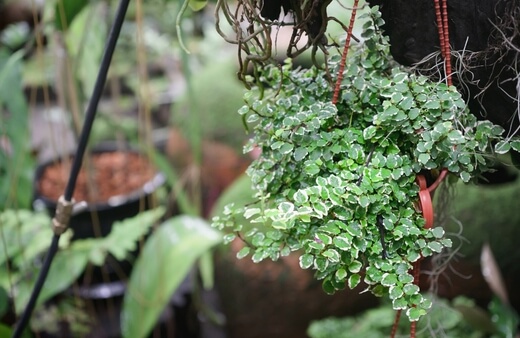
Family: | Moraceae |
|---|---|
Genus: | Ficus |
Species: | F. pumila |
Common Names: | Creeping fig, Climbing fig, Fig ivy |
Location: | Indoor or outdoor |
Type: | Evergreen perennial, climbing shrub |
Growth: | 2.5m |
Sun requirements: | Full sun |
Foliage Colour: | Green |
Flower Colour: | Orange |
Flowering: | Spring and summer |
Fruit: | Drooping green soft fruit in autumn (edible with preparation) |
Maintenance level: | Low |
Poisonous for pets: |
What are Creeping Figs?
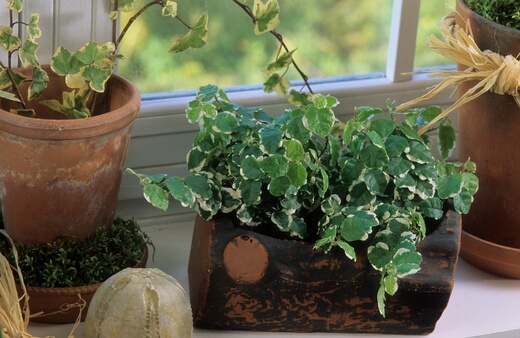
Creeping fig is commonly associated with mulberries, but in reality, it’s just as much a Ficus as more recognizable fig trees, with the only difference being flavour and form. Rather than growing on thick sturdy trunks, climbing fig sprawls over the ground, or up fences and other trees in search of sunlight.
That makes it an ideal replacement for ivy, Virginia creeper, and other traditional climbing plants, as well as being a beautiful ground cover plant. We’ve even grown creeping figs in hanging baskets in the past, but you need plenty of moisture retention to stop it from drying out in summer!
Natural Habitat of Ficus pumila
Creeping figs (Ficus pumila) are native to China, Vietnam, and Japan but are found throughout East Asia and have naturalised in warmer parts of the world thanks to their low-maintenance habit, and love of warm climates.
Provided they are never exposed to freezing temperatures, creeping fig will come back year after year. In cooler parts of the country, it’s best to grow climbing figs up against the house for escaped heat in winter, or indoors to avoid any risk.
Growing Creeping Figs in Australia
Grow creeping fig easily at home with our easy-to-follow guide, from planting through to harvesting. To get you started, let’s run through some of the basic soil, water, and light requirements of these gorgeous trailing plants.
.
Best Conditions to Planting Creeping Fig Outdoors
Creeping fig is a pretty nonchalant plant when it comes to choosing the right place, provided it’s not too dry, or too wet. 99% of Australian gardeners will be able to find a spot for this easy-going plant.
Soil
Reasonably well-drained soil, improved with any organic compost is ideal, providing loose root runs for freshly planted creeping figs. For climbing figs planted in full sun, add some moisture retention crystals, or rotted manure to the planting hole or pot to prevent it from drying out completely through summer and reduce watering needs.
An average pH of 6-6.5 is ideal, but a little higher or lower is ok. Just try not to subject creeping fig to extreme acid, or alkaline conditions.
Light
Creeping fig grows best in full sun, but can cope with light shade, provided it’s in a bright, open space. We’ve got ours on a North facing wall, which is baking hot in summer, and its thick leaves seem very well adapted to the baking sun, despite being a forest plant in its native environment.
Even in shade, this plant can grow well, but will require some reflected light from a bright wall of fence so it gets at least six hours of UV exposure per day.
Temperature
Creeping figs prefer temperatures over 18°C through winter, but will cope down to about 5°C before they show signs of struggle. They thrive in hot summers when temperatures reach 25°C or higher, but will need plenty of water to maintain their vigour.
Water
Water creeping figs whenever their soil begins to dry out. If the surface of the soil is at all moist, do not water as, like all figs, creeping fig does suffer badly from root rot when it sets in and can be very hard to recover.


Get Your Free Guide:
Master Growing Australian Natives eBook
A Must Have Complete Guide for Every Australian Garden
Get Your Free Guide:
Master Growing Australian Natives eBook
A Must Have Complete Guide for Every Australian Garden
In pots and hanging baskets, water this plant at least once a week through summer. This is easily done with a retractable hose reel and watering wand.
How to plant creeping fig
Creeping figs are vigorous growers in their first year, and slow down after about 3-4 years when they reach close to peak size (2.5m or 4m for some varieties). With that in mind, it’s important to plant them into the well-prepared ground.
Dig out a hole that’s at least twice the size of their pot, and plant them at the same level in the ground as they were in the container, leaving them just slightly proud of the soil so they don’t sit in puddles at first.
Water them in really generously (at least one full watering can). This just settles the soil around their roots for the first few weeks and gives their roots easy access to moisture while they grow outwards.
Growing Creeping Fig Indoors
For indoor creeping figs, plant them in any garden compost, with a 50% soil content. Place their containers in a bright spot and water them at least once a fortnight, or when the soil surface is dry to the touch.
We prefer to grow creeping figs in indoor hanging baskets so they can grow naturally without pruning, but if you grow them in containers against a wall, provide them with support using wall hooks, or wireframes so they have something to cling to.
If you prefer to grow your creeping figs using hanging baskets then you will love our list of hanging baskets you can make on your own or get onlineGuide to Propagating Creeping Figs
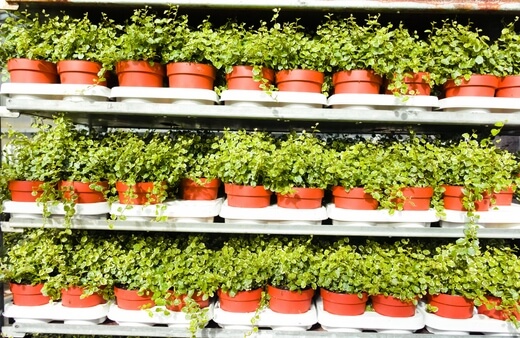
It is possible to grow this plant from seed, but it takes a lot of time, so I always advise growers to start new plants from cuttings, which take easily, and require very little attention.
Creeping figs have tons of hormones built into their nodes, so are one of the easiest plants to propagate from cuttings.
Creeping Fig Propagation from Cuttings
You can propagate creeping figs at any time of year, but spring is by far the best time to do it, after new growth is shooting out from last year’s vines. Before you take any cuttings from this plant, you can boost your success rate by watering them the day before.
Watering them, especially in spring, will boost growth, and fill every cell with the energy, nutrients, and hormones it needs to support new root growth.
To take cuttings, you will need:
- Sharp pruning scissors
- Plastic pots
- Rooting hormone - see our rooting hormone buying guide here.
- Sieved used compost or sieved garden soil
- Perlite
Method:
- Start by sieving your compost or soil into a pot, and mixing it 50:50 with perlite to aid drainage.
- Lightly moisten the soil, then dib holes 2” apart using the end of a pencil.
- Take fresh growing tips from creeping fig vines, and remove all but the topmost leaves.
- Cut your cutting just below a node, keeping it about 5-8cm long in total.
- Dip the cut end in the rooting hormone.
- Pop cuttings into the holes in the compost, and water it until the soil falls in around the stems.
- Place a clear plastic bag over the pot, and check it once a week for signs of new growth.
- Water if the soil dries out.
- After 2-3 months, they should have begun to root well.
- Gently separate each cutting, and plant it into its own pot to grow on.
How to Care for Creeping Figs
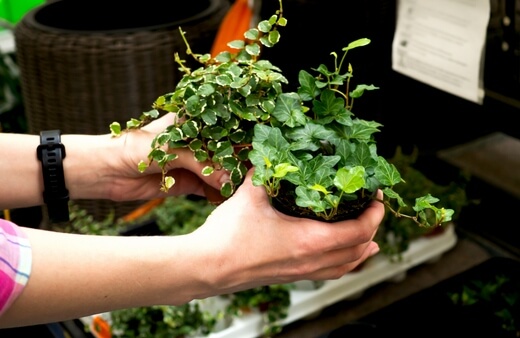
This plant really don’t need much in the way of fertiliser, pruning, or repotting, as they focus the vast majority of their energy on top growth, rather than roots. However, it’s still important to keep an eye on changes in plant health and act accordingly.
I’ve put together some simple ways to adjust plant health based on common signs, using basic fertilisers and pruning techniques below.
Best Fertiliser for Climbing Figs
The best time to feed this plant is in spring. One feed, or mulch for outdoor plants, will be enough to improve the soil quality for the year ahead. If you notice that the leaves have lost colour and vigour, or the growth rate has slowed down in the first three years, add some nitrogen to the soil by mulching with rotted manure.
If you use liquid fertilisers on indoor plants, feed creeping fig with a diluted feed once a month to avoid yellow leaves.
Pruning Needs
This plant doesn’t need pruning, but young plants can be cut back to encourage lateral growth, and more vines in the long run. Over time, your plant will n naturally form a similar shape, no matter how it is pruned, but you can create a better structure for young plants with light pruning of top growth in early summer.
If you notice any blackened leaves or brown spots on foliage, remove a foot of the vine attached to that leaf to prevent the spread of possible infection.
Repotting Creeping fig
For creeping figs in pots or hanging baskets, it’s well worth repotting them every two or three years. Their roots will develop and slowly outgrow their containers. Dividing them will create new plants while planting them into larger pots will promote new, more vigorous growth.
Harvesting & Preparing Creeping Fig
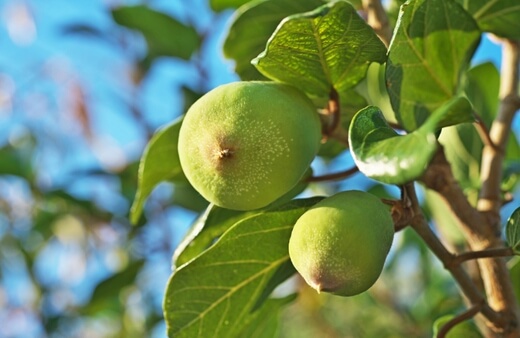
Creeping fig doesn’t have the same soft, sweet, flavour as standard figs, but the fruit looks strikingly similar, and can in fact be eaten with proper preparation. I tried out one method with good success last year and made a few notes to share with you:
How to Prepare Creeping Fig
Pick creeping figs when they are fully ripe, and squeeze easily. Then cut the fruit in half and press on the skin side to turn it inside out (this makes the next part easier).
Place the fruit, seeds, skin, and all, into a muslin bag and squeeze until all the juice runs out. The juice should be thick and gelatinous. Then simply cool it. That’s it.
The cooled jelly sets easily and can be eaten as a sweet treat in itself, or flavoured with lemon or lime juice for a refreshing treat.
Climbing Fig Pests and Diseases
This plant rarely suffer from pests and diseases, but do not like to be overwatered. Over-watering climbing figs can cause root rot, which will lead to blacked stems, and wilting, yellow leaves which look low in nutrients.
If you suspect root rot or the beginning of it, let the soil dry out and see if the plant starts to recover If it doesn’t recover after two weeks, take cuttings from healthy parts of the plant as insurance, and then re-pot the rest of it, cutting away any damaged roots in the process.
Creeping Fig Frequently Asked Questions
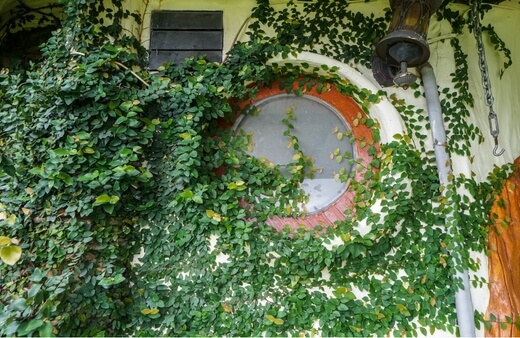
Is creeping fig easy to grow?
Climbing fig is a low-maintenance plant, whether it’s growing indoors or out. Simply water it evenly without drenching it, and give it plenty of sunlight and you’ll have a happy, healthy plant for years to come, which covers walls and fences with more delicate foliage than common ivy.
Does creeping fig damage walls?
Creeping fig won’t damage masonry but will damage fences and timber that it climbs up due to its grabbing roots which dig into the porous surface. Avoid planting creeping fig near structural timber.
Is creeping fig poisonous?
While the fruit is edible in the right preparation, the plant itself produces a sap that is highly irritating to the skin and can cause vomiting and diarrhoea when ingested. Creeping fig is considered toxic to cats and dogs.
Is creeping fig invasive?
Personally, I don’t see climbing fig as invasive, but it certainly is vigorous and should be controlled by digging out any running roots that grow beyond their intended space. Creeping figs can quickly take over garden beds.
For more ficus plants, check out our comprehensive guide to growing Ficus coronata, commonly known as the Sandpaper fig tree.
Enjoy the Simple Beauty Creeping Figs will bring to Your Garden
Creeping fig has its downfalls, and can be hard to keep in check with vigorous growth that is well suited to Australian gardens, but for all of its negatives, it has double the merits. There are so many plants that can grow as wall coverings, but I don’t think there are any with the simple natural beauty that climbing figs can bring to a garden.
I adore creeping figs, and wouldn’t have a garden without them. Now you know how to grow creeping fig, as well as making use of those tricky fruits, you’ve got no excuse, so go out and find one for your garden.
Published on October 30, 2022 by Maisie Blevins
Last Updated on February 22, 2024




